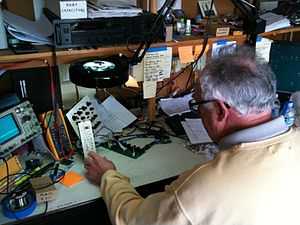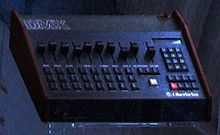Tom Oberheim

Thomas Elroy Oberheim (Born July 7, 1936, Manhattan, Kansas), known as Tom Oberheim, is an audio engineer best known for designing effects processors, analog synthesizers, sequencers, and drum machines. He has been the founder of four audio electronics companies, most notably Oberheim Electronics. He was also a key figure in the development and adoption of the MIDI standard.
Early years
Oberheim was born and raised in Manhattan, Kansas. Beginning in junior high school, he put his interest in electronics to work by building hi-fi components and amplifiers for friends. A fan of jazz music, Oberheim decided to move to Los Angeles after seeing an ad on the back of Downbeat Magazine about free jazz performances at a club there. He arrived in Los Angeles in July 1956 at the age of 20 with $10 in his pocket.[1] He worked as a draftsman trainee at NCR Corporation where he was inspired to become a computer engineer. Oberheim enrolled at UCLA, studying computer engineering and physics while also taking music courses. Over the next nine years he worked toward his physics degree, serving in the Army for a short period of time, harmonizing with the Gregg Smith Singers, and working jobs at computer companies (most notably Abacus, where he first began designing computers).[1]
Oberheim Electronics and Maestro
Oberheim was attending a class during his last semester at UCLA when he met and became friends with trumpet player Don Ellis, and keyboardist Joseph Byrd of the band The United States of America, who were attending the same class. Oberheim stayed in touch with both Ellis and Byrd after leaving UCLA, and ended up building an amp for Ellis to use for his PA system. Oberheim also built guitar amps for The United States of America, and their lead singer Dorothy Moskowitz asked him to build a ring modulator for the band (Joseph Byrd had used one while a band member, and Moskowitz wanted one for the band's new keyboardist, Richard Grayson). While ring modulator circuit information was readily available, it was a 1961 article by Harald Bode in Electronics Magazine that gave Oberheim the information he needed to design and hand-build one for musical application. Oberheim also built a ring modulator for Don Ellis. After hearing about Oberheim's device, film composer Leonard Rosenman contacted him for a ring modulator to use in the production of the Beneath the Planet of the Apes film soundtrack.[2] Oberheim, who had grown tired of designing computer equipment, found far greater personal satisfaction in designing equipment used by artists to create music and the positive feedback he received from musicians like Herbie Hancock and Jan Hammer.[3]
In 1969, the Chicago Musical Instruments Company (CMI) approached Oberheim about his ring modulator, wanting him to become one of their manufacturing contractors. Oberheim raised approximately $6,000 from friends to start Oberheim Electronics. (One of the original investors was Tony Russo, but Oberheim later returned Russo's investment at Russo's request.) Oberheim produced his ring modulator, which CMI marketed as the Maestro RM-1A. At the time, Oberheim was also spending time with the band Bryndle, and had developed a fascination with the sound of instruments being played through a Leslie rotary speaker. This inspired Oberheim to design and build a digital phase shifter effects unit to imitate that sound. Maestro marketed the phase shifter as the PS-1. The PS-1 was a huge success, selling nearly 25,000 units over the next three years. Oberheim went on to design other products for Maestro, including the Universal Synthesizer for guitars.[1][2]
Synthesizer designer
.jpg)
Oberheim's forays into the design of equipment to be used by musicians continued to evolve. His associations with Richard Grayson and later Paul Beaver nurtured an interest in synthesizers, and at the 1971 NAMM Show, Oberheim approached Alan R. Pearlman of ARP Instruments, Inc., asked to become the company's Los Angeles dealer, and subsequently became ARP's first dealer on the west coast, selling ARP 2600 synthesizers to musicians in the Los Angeles area, including Leon Russell, Robert Lamm, and Frank Zappa.[4] Having access to ARP's schematics, Oberheim noticed that the ARP 2500 had a feature that allowed two notes to be played simultaneously (which neither the 2600 nor other commercially available synthesizers at that time were capable of), and Oberheim designed a modification to the ARP 2600 that enabled it to do the same thing.[4] Using two of these modified ARP 2600s, Oberheim and Grayson performed concerts together.
Oberheim further expanded on the performance capabilities of 2-note polyphony in 1973, using his computer engineering experience to design the DS-2, one of the first digital sequencers. The sequencer would completely control the synthesizer, however, leaving the musician with no way to play along, a problem that inspired Oberheim to design a Synthesizer Expansion Module (aptly named the SEM) with the design assistance of Dave Rossum (later of E-MU Systems fame). Oberheim first showed the SEM, the first synthesizer bearing his company's name, at the Audio Engineering Society convention in Los Angeles in May 1974.[3]


By 1980, Oberheim's products, by then including synthesizers, a polyphonic digital sequencer (the DSX), and a sampled-sound drum machine (the DMX) were designed to be combined to form a complete system, and could be interconnected by a proprietary Oberheim parallel buss interface which pre-dated MIDI.[10]
MIDI proponent
In June 1981, Roland's Ikutaro Kakehashi approached Oberheim with the idea of standardizing a communication protocol between electronic music instruments. Oberheim discussed the idea with Dave Smith of Sequential Circuits, and in November, Smith formally presented the idea to the Audio Engineering Society. Smith finalized the MIDI specification and together, Kakehashi, Oberheim, and Smith successfully coordinated the support of all major manufacturers to widely adopt the new MIDI standard.[11]
Marion Systems and SeaSound
By May 1985, Oberheim Electronics was struggling and became ECC/Oberheim, owned by Oberheim's ex-lawyer. Later that same year, the Oberheim name was sold to Gibson Guitar Company. Tom Oberheim departed the company two years later and filed a lawsuit against his ex-lawyer for legal malpractice.[12][13][14]
In 1987, Oberheim formed Marion Systems (named after his daughter Emily Marion) in Santa Monica and later Lafayette in California. During this time, Oberheim performed consulting work for Roland and Akai, and produced a 12-bit to 16-bit option for Akai's S900 sampler. Oberheim also developed the Marion Systems MSR-2, a modular synthesizer concept.[15]
In the year 2000 after Marion Systems, Oberheim founded SeaSound, a manufacturer of audio interfaces.[16]

Return of Oberheim
In 2009, Oberheim began hand-building and selling an updated SEM synthesizer with upgraded features, but with a true analog design as faithful to the sound of his original SEM as possible.[17] In 2010, he announced plans to release the "Son of Four Voice," an updated version of his original Oberheim 4-Voice analog synthesizer.[18]
Breakfast Club
Oberheim was a core member of "The Dead Presidents Society", an informal discussion group which met weekly in a Berkeley coffeehouse. The group took its name from the fact that most members were formerly presidents of companies that had gone out of business. Other notable innovators in technology and music who made up the group were Don Buchla, John Chowning, John Lazzaro, Ingrid Linn, Roger Linn, Max Mathews, Keith McMillen, Dave Smith and David Wessel.[19] The group shed the "Dead Presidents" name when it opened up to other members including professors from Stanford University and the University of California, Berkeley. Its new name is the Breakfast Club.[20]
References
- Mark Vail (1993). Vintage Synthesizers. Miller Freeman Books. ISBN 978-0-87930-603-8.
- Mark Jenkins (2007). Analog Synthesizers. Elsevier Ltd.
- ↑ 1.0 1.1 1.2 "Tom Oberheim: Polyphonic One Love" (transcript of video lecture). Red Bull Music Academy, Barcelona, 2008.
- ↑ 2.0 2.1 Trevor Pinch and Frank Trocco. Analog Days: the Invention and Impact of the Moog Synthesizer. Harvard University Press. p. 270. ISBN 978-0-674-01617-0.
- ↑ 3.0 3.1 Dominic Milano. "Oberheim, Designer of Synthesizers". Contemporary Keyboard (May 1977).
- ↑ 4.0 4.1 Mark Vail, p. 120
- ↑ Mark Vail, p. 44
- ↑ Mark Vail, p. 153
- ↑ Julian Colbeck (1996). Keyfax Omnibus Edition. MixBooks. p. 85. ISBN 978-0-918371-08-9.
- ↑ Joel Chadabe (April 1, 2001). "The Electronic Century Part III: Computers and Analog Synthesizers". Electronic Musician.
- ↑ Mark Jenkins, p. 69
- ↑ Mark Jenkins, p. 70
- ↑ Joel Chadabe (May 1, 2001). "The Electronic Century Part IV: The Seeds of the Future". Electronic Musician.
- ↑ Mark Jenkins, p. 72
- ↑ Mark Vail, p. 154
- ↑ Joel Chadabe (1997). Electric Sound: The Past and Promise of Electronic Music. Prentice Hall. p. 199. ISBN 978-0-13-303231-4.
- ↑ "Tom Oberheim: The Man who made Marion - Interview, Manufacturer". Sound On Sound (March 1994).
- ↑ "SeaSound Solo EX - Computer Recording System". Sound On Sound (Dec 2000).
- ↑ Gordon Reid. "Tom Oberheim SEM - Analogue Synthesizer". Sound On Sound (Sep 2010).
- ↑ "Oberheim Son of 4-voice Brings Back Vintage 70s Synth Sound Design". Synthtopia.com. Jan 2011.
- ↑ "The Dead Presidents Society". Roger Linn Design.
- ↑ Robair, Gino (May 12, 2010). "Genius Bar: An esteemed group of music-technology pioneers offer their visions for the future of electronic instruments". Electronic Musician (NewBay Media).